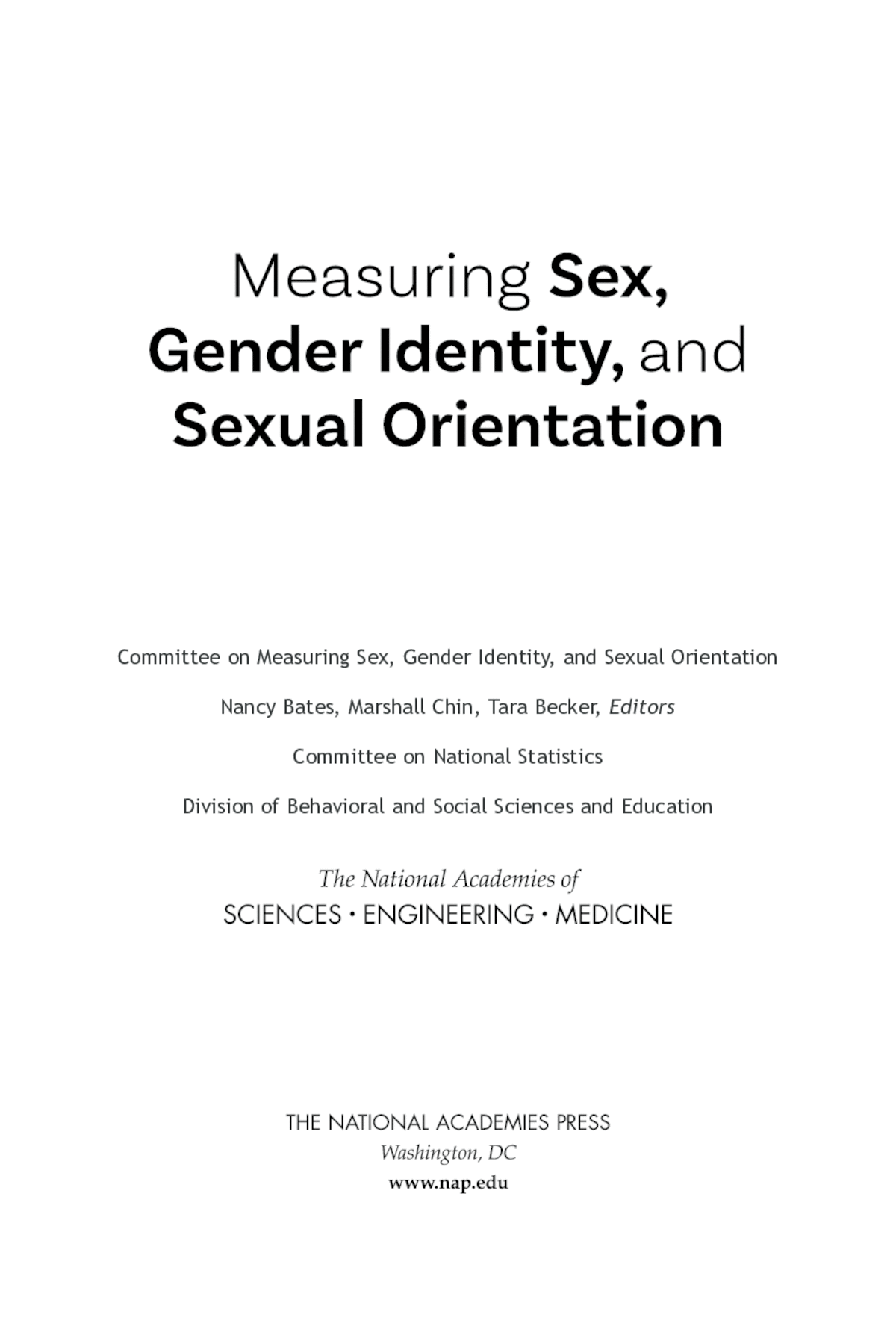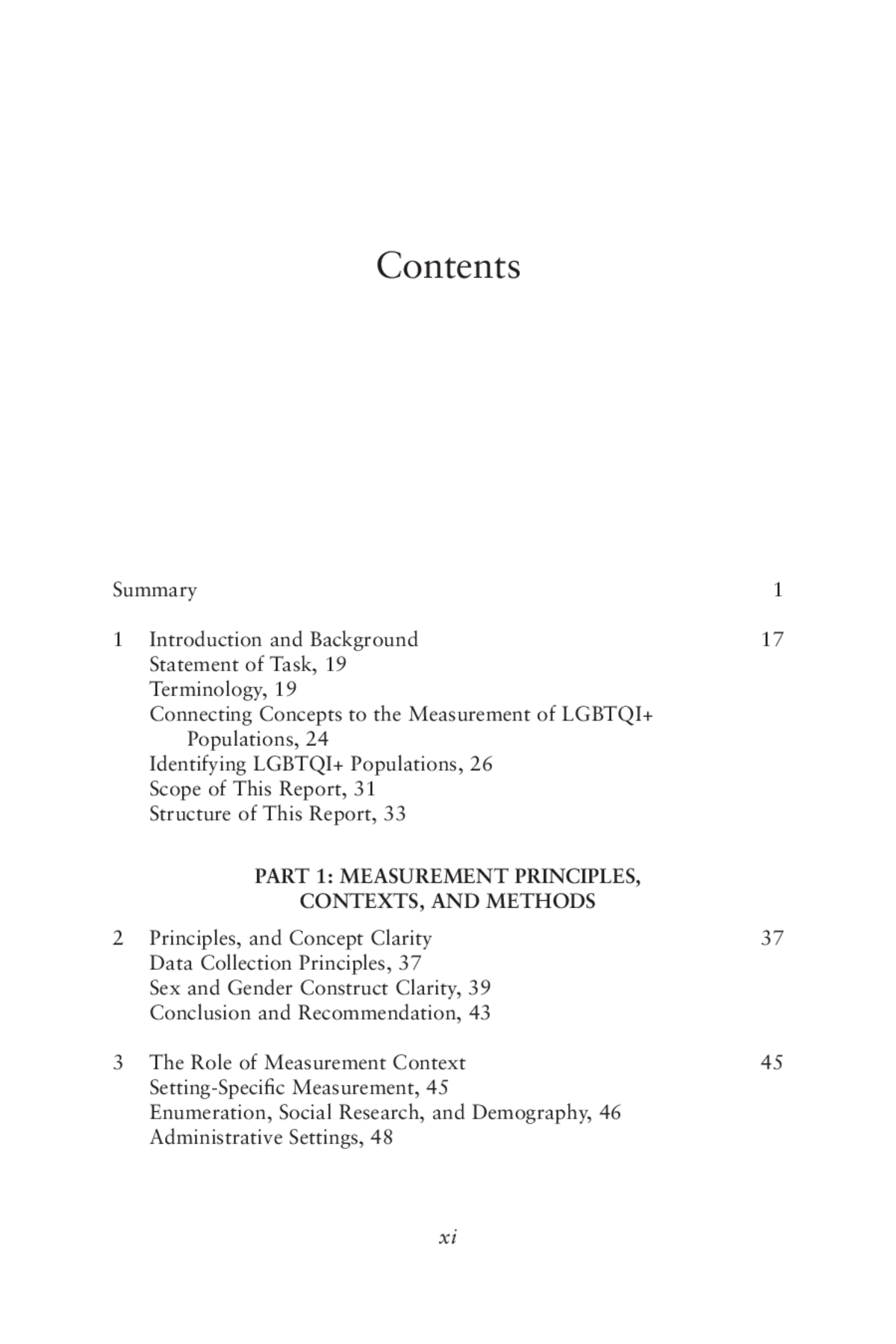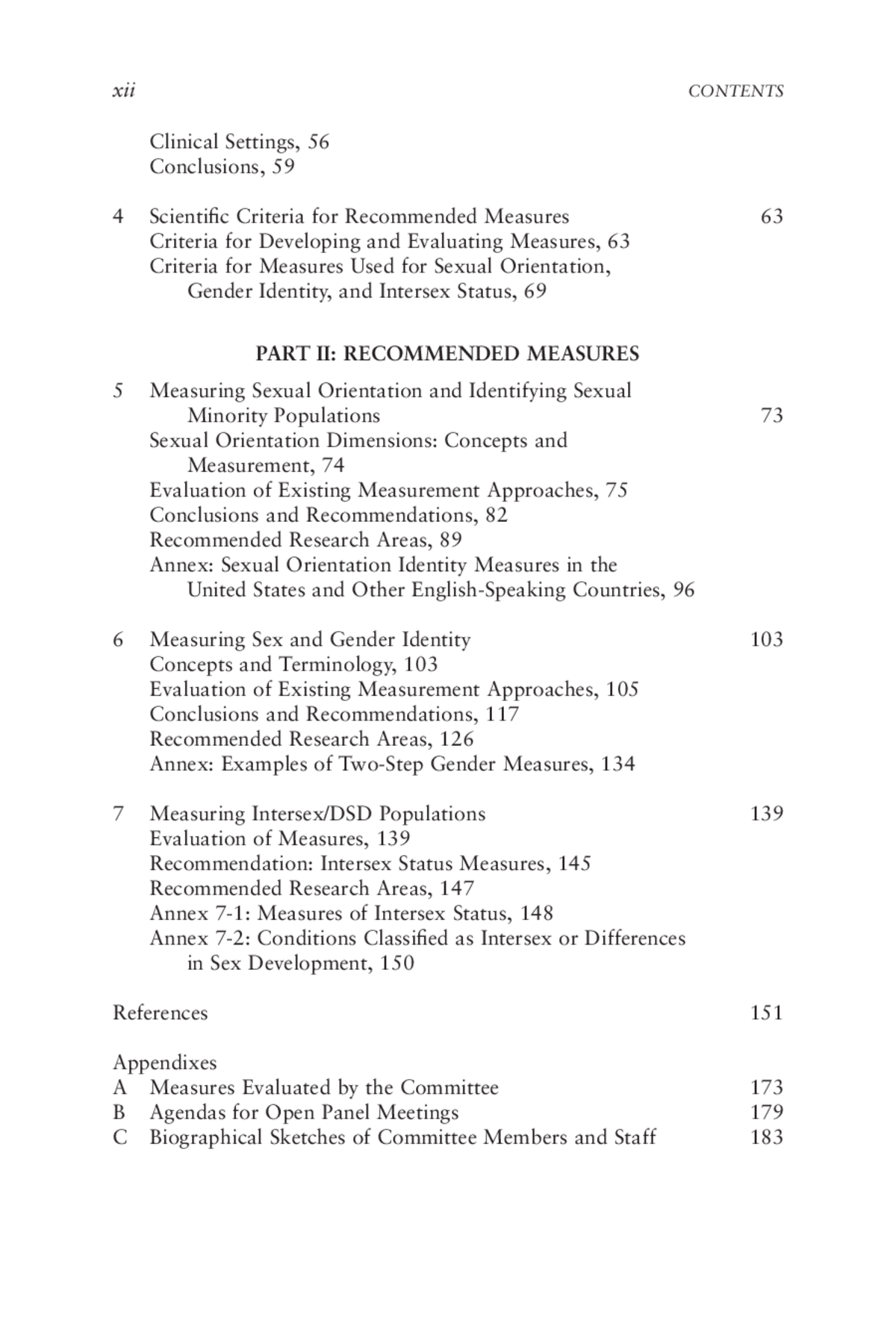Measuring Sex,
Gender Identity, and
Sexual Orientation
Committee on Measuring Sex, Gender Identity, and Sexual Orientation
Nancy Bates, Marshall Chin, Tara Becker, Editors
Committee on National Statistics
Division of Behavioral and Social Sciences and Education
![]()
THE NATIONAL ACADEMIES PRESS
Washington, DC
www.nap.edu
THE NATIONAL ACADEMIES PRESS 500 Fifth Street, NW Washington, DC 20001
This activity was supported by contracts between the National Academy of Sciences and the National Institutes of Health (HHSN263201800029I, 75N98021F00001). Any opinions, findings, conclusions, or recommendations expressed in this publication do not necessarily reflect the views of any organization or agency that provided support for the project.
International Standard Book Number-13: 978-0-309-27510-1
International Standard Book Number-10: 0-309-27510-5
Digital Object Identifier: https://doi.org/10.17226/26424
Library of Congress Control Number: 2022937869
Additional copies of this publication are available from the National Academies Press, 500 Fifth Street, NW, Keck 360, Washington, DC 20001; (800) 624-6242 or (202) 334-3313; http://www.nap.edu.
Copyright 2022 by the National Academy of Sciences. All rights reserved.
Printed in the United States of America
Suggested citation: National Academies of Sciences, Engineering, and Medicine. 2022. Measuring Sex, Gender Identity, and Sexual Orientation. Washington, DC: The National Academies Press. https://doi.org/10.17226/26424.
![]()
The National Academy of Sciences was established in 1863 by an Act of Congress, signed by President Lincoln, as a private, nongovernmental institution to advise the nation on issues related to science and technology. Members are elected by their peers for outstanding contributions to research. Dr. Marcia McNutt is president.
The National Academy of Engineering was established in 1964 under the charter of the National Academy of Sciences to bring the practices of engineering to advising the nation. Members are elected by their peers for extraordinary contributions to engineering. Dr. John L. Anderson is president.
The National Academy of Medicine (formerly the Institute of Medicine) was established in 1970 under the charter of the National Academy of Sciences to advise the nation on medical and health issues. Members are elected by their peers for distinguished contributions to medicine and health. Dr. Victor J. Dzau is president.
The three Academies work together as the National Academies of Sciences, Engineering, and Medicine to provide independent, objective analysis and advice to the nation and conduct other activities to solve complex problems and inform public policy decisions. The National Academies also encourage education and research, recognize outstanding contributions to knowledge, and increase public understanding in matters of science, engineering, and medicine.
Learn more about the National Academies of Sciences, Engineering, and Medicine at www.nationalacademies.org.
![]()
Consensus Study Reports published by the National Academies of Sciences, Engineering, and Medicine document the evidence-based consensus on the study’s statement of task by an authoring committee of experts. Reports typically include findings, conclusions, and recommendations based on information gathered by the committee and the committee’s deliberations. Each report has been subjected to a rigorous and independent peer-review process and it represents the position of the National Academies on the statement of task.
Proceedings published by the National Academies of Sciences, Engineering, and Medicine chronicle the presentations and discussions at a workshop, symposium, or other event convened by the National Academies. The statements and opinions contained in proceedings are those of the participants and are not endorsed by other participants, the planning committee, or the National Academies.
For information about other products and activities of the National Academies, please visit www.nationalacademies.org/about/whatwedo.
COMMITTEE ON MEASURING SEX, GENDER IDENTITY, AND SEXUAL ORIENTATION
NANCY BATES (Co-Chair), Retired, U.S. Census Bureau
MARSHALL CHIN (Co-Chair), Department of Medicine, University of Chicago
KELLAN E. BAKER, Whitman-Walker Institute, Whitman-Walker Health
JOSÉ A. BAUERMEISTER, Department of Family and Community Health, University of Pennsylvania
D’LANE COMPTON, Department of Sociology, University of New Orleans KATHARINE DALKE, Department of Psychiatry and Behavioral Health, Pennsylvania State University College of Medicine
ALIYA SAPERSTEIN, Department of Sociology, Stanford University
KARINA WALTERS, School of Social Work, University of Washington
BIANCA D. M. WILSON, Williams Institute, University of California, Los Angeles, School of Law
TARA BECKER, Study Director
KATRINA BAUM STONE, Senior Program Officer
ERIC GRIMES, Senior Program Assistant
COMMITTEE ON NATIONAL STATISTICS
ROBERT M. GROVES (Chair), Office of the Provost, Georgetown University
LAWRENCE D. BOBO, Department of Sociology, Harvard University
ANNE C. CASE, Woodrow Wilson School of Public and International Affairs, Princeton University, Emeritus
MICK P. COUPER, Institute for Social Research, University of Michigan
JANET M. CURRIE, Woodrow Wilson School of Public and International Affairs, Princeton University
DIANA FARRELL, JPMorgan Chase Institute, Washington, DC
ROBERT GOERGE, Chapin Hall at the University of Chicago
ERICA L. GROSHEN, School of Industrial and Labor Relations, Cornell University
HILARY HOYNES, Goldman School of Public Policy, University of California, Berkeley
DANIEL KIFER, Department of Computer Science and Engineering, The Pennsylvania State University
SHARON LOHR, School of Mathematical and Statistical Sciences, Arizona State University, Emeritus
JEROME P. REITER, Department of Statistical Science, Duke University
JUDITH A. SELTZER, Department of Sociology, University of California, Los Angeles, Emeritus
C. MATTHEW SNIPP, School of the Humanities and Sciences, Stanford University
ELIZABETH A. STUART, Department of Mental Health, Johns Hopkins Bloomberg School of Public Health
JEANNETTE WING, Data Science Institute and Computer Science Department, Columbia University
BRIAN HARRIS-KOJETIN, Director
MELISSA CHIU, Deputy Director
CONSTANCE F. CITRO, Senior Scholar
Preface
Sex, gender identity, and sexual orientation are core to an individual’s understanding of who they are, and these characteristics shape each person’s experiences, relationships, and opportunities throughout their lives. Together, these important demographic characteristics are the axes through which personal and societal beliefs about sex (gender) differences play out within people’s lives, structuring behaviors and creating gender-based inequality that can manifest itself in many ways, including as segregation, discrimination, violence, sexism, homophobia, and transphobia. Understanding the wide-ranging effects of sex, gender identity, and sexual orientation, their causes and their consequences, is crucial, but doing so requires the development and use of validated measures that can represent the underlying complexity of constructs that are often assumed to be simple and uncomplicated.
Collection of sex and gender data occurs routinely in research, health, and administrative data collection efforts. Most of these efforts have long treated sex and gender as binary, mutually determined (usually at birth), and interchangeable constructs that can each serve as a proxy for the other. Although it is less routinely collected, sexual orientation is also based on a binary that assumes there is unity between sex and gender because it is generally defined on the basis of the sex/gender of one’s preferred partner(s) relative to one’s own: same-sex/gender, opposite-sex/gender, both sexes/genders.
This simple binary, however, masks a more complicated reality in which a constellation of sex traits may not all correspond to the same sex; and an
individual’s gender identity may not be the same as their sex and may lie outside the binary of male/female. Thus, these simple, binary measures of either sex or gender do not represent this complexity and may pose difficulties for respondents whose sex traits do not all correspond to the same sex or whose sex is different from their gender identity, namely, intersex and transgender people. These difficulties then extend to other measures that are derived from sex/gender, such as sexual orientation. These measurement issues are not purely academic: they can have severe consequences for sexual and gender minorities in health care and other areas in which measures of sex/gender and sexual orientation are often used for determining appropriate and necessary care.
It was within this context that 19 separate institutes, centers, and offices of the National Institutes of Health (NIH) asked the National Academies of Sciences, Engineering, and Medicine (the National Academies) to undertake a study to examine the measurement of sex, gender identity, and sexual orientation and produce recommendations for specific measures that can be used in surveys and research, administrative, and clinical and other health settings. Underscoring the importance of this issue within many fields of interest, the 19 NIH entities included: the National Cancer Institute; the National Human Genome Research Institute; the National Institute on Aging; the National Institute of Allergy and Infectious Diseases; the Eunice Kennedy Shriver National Institute of Child Health and Human Development; the National Institute of Environmental Health Sciences; the National Institute of Mental Health; the National Institute of Minority Health and Health Disparities; the National Institute of Neurological Disorders and Stroke; the Office of the Director, All of Us; the Office of the Director, Chief Officer for Scientific Workforce Diversity; the Office of the Director, Division of Program Coordination, Planning, and Strategic Initiatives, Office of AIDS Research; the Office of the Director, Division of Program Coordination, Planning, and Strategic Initiatives, Office of Behavioral and Social Sciences Research; the Office of the Director, Division of Program Coordination, Planning, and Strategic Initiatives, Office of Disease Prevention; the Office of the Director, Division of Program Coordination, Planning, and Strategic Initiatives, Office of Research on Women’s Health; the Office of the Director, Division of Program Coordination, Planning, and Strategic Initiatives, Office of Strategic Coordination; the Office of the Director, Division of Program Coordination, Planning, and Strategic Initiatives, Sexual & Gender Minority Research Office; Office of the Director, Office of Equity, Diversity, and Inclusion; and the Office of the Director, Office of Intramural Research, Office of Intramural Training and Education. In response to this request, the National Academies appointed the Committee on Measuring Sex, Gender Identity, and Sexual Orientation (under the standing committee of the Committee on National Statistics) to carry out this task. Nine
scholars representing a broad array of disciplines—medicine, psychology, public health, sociology, survey methodology, and statistics—were included on the committee, which met virtually seven times over the 9-month period between May 2021 and January 2022.
This report presents an accounting of the process the committee used to evaluate existing measures of sex, gender identity, and sexual orientation and recommend specific measures to be used to standardize federal data collection efforts. This evaluation revealed not only how much progress has been made in the development and refinement of sex, gender identity, and sexual orientation measures that identify sexual and gender minority populations, but also how much progress remains to be made. Although measures of sex and gender that enable the identification of transgender respondents and measures of sexual orientation have improved and become more widely implemented in data collection efforts, few of the measures in use are explicitly inclusive of gender identities that lie outside of the gender binary, and many continue to rely on terminology or language that is considered invalidating or offensive to some sexual and gender minorities. And to date, much less progress has been made in developing measures that identify people with intersex traits. Thus, this report serves as a starting point not only for those looking to expand their sex, gender identity, and sexual orientation data collection efforts, but also for those who wish to focus on further improvement and refinement of these measures. To this end, the report recommends specific areas for future research and question development.
This report would not have been possible without the contributions of many people. Special thanks must be extended to members of the study committee, who devoted extensive time, thought, and energy to this endeavor. The committee received useful information and insights from presentations from outside experts at open sessions of committee meetings. We thank Sari van Anders (Queen’s University), Ethan Fechter-Leggett (National Institute for Occupational Safety and Health, Centers for Disease Control and Prevention), Kirk Greenway (Indian Health Service), Elliot Kennedy (Administration for Community Living, U.S. Department of Health and Human Services), Mahri Monson (Environmental Protection Agency), Jennifer Truman (Bureau of Justice Statistics), Courtney Finlayson (Lurie Children’s Hospital of Chicago), Elizabeth Reis (City University of New York), Jason Flatt (University of Nevada, Las Vegas), Harper Jean Tobin (HJ Tobin Policy Consulting), Vadim Shteyler (University of California, San Francisco), Jack Byrne (University of Waikato), Jaimie Veale (University of Waikato), Micah Davison (Statistics New Zealand), Sean Cahill (The Fenway Institute), Juno Obedin-Maliver (Stanford University), and Clair Kronk (Yale University). Additionally, Robert Cronin (Vanderbilt University) provided statistical information from the All of Us study.
A number of staff members of the National Academies made significant contributions to the report. Jordyn White and Katrina Stone served as program officers and provided important research support. Eric Grimes made sure that committee meetings ran smoothly, and he and Rebecca Krone assisted in preparing the manuscript and otherwise provided key administrative and logistical support; Kirsten Sampson Snyder managed the report review process; Yvonne Wise managed the report production process; and Brian Harris-Kojetin, director of the Committee on National Statistics, provided valuable guidance and oversight. We also thank Eugenia Grohman for her editing of the report.
This Consensus Study Report was reviewed in draft form by individuals chosen for their diverse perspectives and technical expertise. The purpose of this independent review is to provide candid and critical comments that will assist the National Academies in making each published report as sound as possible and to ensure that it meets the institutional standards for quality, objectivity, evidence, and responsiveness to the study charge. The review comments and draft manuscript remain confidential to protect the integrity of the deliberative process.
We thank the following individuals for their review of this report: Elizabeth L. Cope (AcademyHealth), Kari J. Dockendorff (Colorado State University), Margo Edmunds (AcademyHealth), Jason D. Flatt (University of Nevada, Las Vegas), M. Paz Galupo (Towson University), Kirk Greenway (Indian Health Service), Jody L. Herman (Williams Institute, University of California, Los Angeles), Michelle M. Johns (NORC at University of Chicago), Charles F. Manski (Northwestern University), Kristina Olson (Princeton University), Tonia Poteat (University of North Carolina), Samuel H. Preston (University of Pennsylvania), Kristen Schilt (University of Chicago), and Carl Streed (Boston University School of Medicine).
Although the reviewers listed above provided many constructive comments and suggestions, they were not asked to endorse the conclusions or recommendations of this report nor did they see the final draft before its release. The review of this report was overseen by Yu Xie (Princeton University) and Bradford Gray (Urban Institute). They were responsible for making certain that an independent examination of this report was carried out in accordance with the standards of the National Academies and that all review comments were carefully considered. Responsibility for the final content rests entirely with the authoring committee and the National Academies.
Nancy Bates, Co-Chair
Marshall Chin, Co-Chair
Tara Becker, Study Director
Committee on Measuring Sex, Gender Identity, and Sexual Orientation
Contents
Connecting Concepts to the Measurement of LGBTQI+ Populations
Identifying LGBTQI+ Populations
PART 1: MEASUREMENT PRINCIPLES, CONTEXTS, AND METHODS
2 Principles, and Concept Clarity
Sex and Gender Construct Clarity
3 The Role of Measurement Context
4 Scientific Criteria for Recommended Measures
Criteria for Developing and Evaluating Measures
Criteria for Measures Used for Sexual Orientation, Gender Identity, and Intersex Status
5 Measuring Sexual Orientation and Identifying Sexual Minority Populations
Sexual Orientation Dimensions: Concepts and Measurement
Evaluation of Existing Measurement Approaches
Conclusions and Recommendations
6 Measuring Sex and Gender Identity
Evaluation of Existing Measurement Approaches
Conclusions and Recommendations
Annex: Examples of Two-Step Gender Measures
7 Measuring Intersex/DSD Populations
Recommendation: Intersex Status Measures
Annex 7-1: Measures of Intersex Status
Annex 7-2: Conditions Classified as Intersex or Differences in Sex Development
A Measures Evaluated by the Committee












